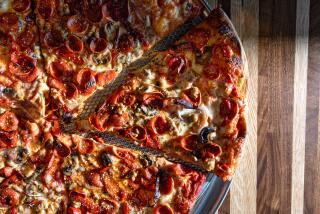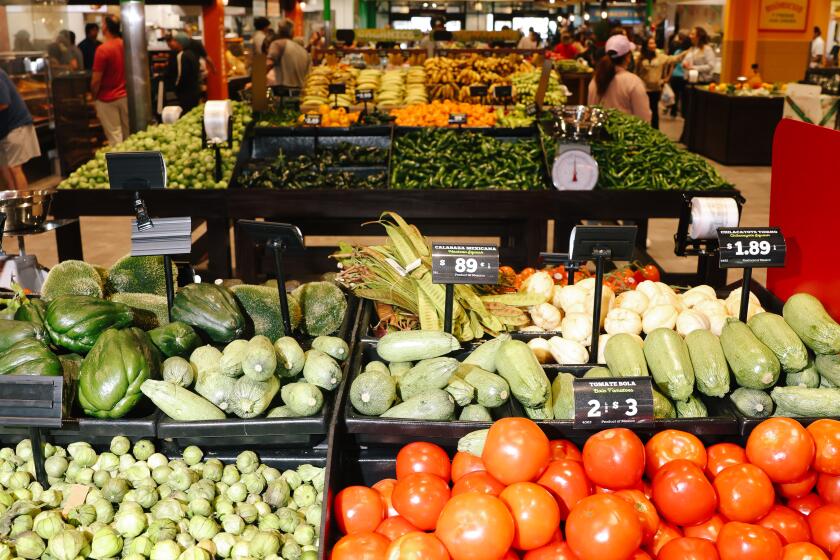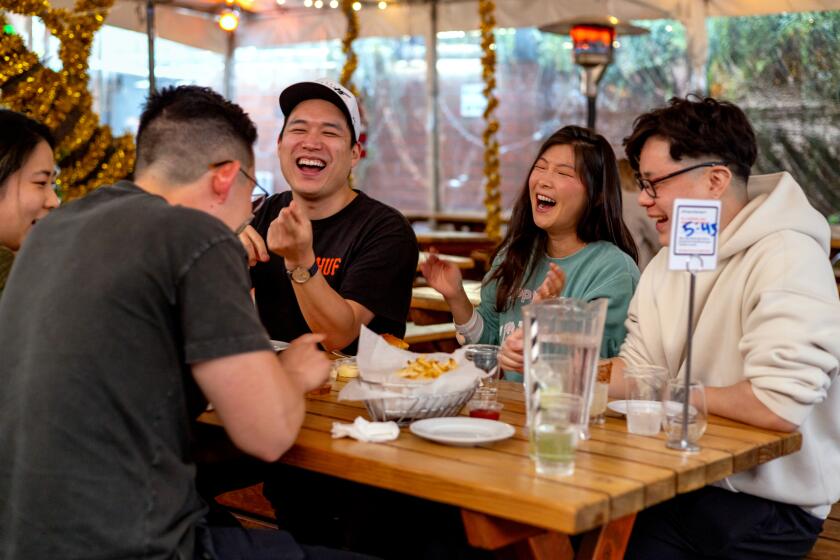Catering to new tastes
Arlene Ciolino started the day with 75 minutes of aerobics, followed by 1 1/2 hours of yoga. So by noon she was hungry. She stowed her blue exercise mat, doffed her white sweatshirt and bellied up to the salad bar.
First came a layer of crisp romaine lettuce, then a scoop of chicken salad, a drizzle of Caesar dressing, a few croutons and a dusting of parmesan. A whole-wheat roll rounded out the meal.
It was light and health-conscious, just like Ciolino, a slender 67-year-old retired bookkeeper. On this drizzly Thursday afternoon, she was lunching at the uncharted edge of aging in America: a senior center 15 miles south of San Francisco that is working to attract a new generation of diners with meals to match their active lives.
Check the menu at the federally subsidized lunch program in a handful of progressive places nationwide and you’ll see your grandmother’s mashed potatoes and gravy nudged aside by fresh, organic and al dente foods demanded by a younger population more interested in arugula than arthritis.
Unlike the elderly diners who came before them, these folks were influenced more by the food revolution of the 1970s (think Alice Waters) than the Great Depression of the 1930s (think Hoovervilles).
And they are beginning to leave their mark on the Meals on Wheels Assn. of America, one of the biggest senior lunch providers in the nation, which launched an in-house think tank last year to “reinvent, redesign and re-engineer” its services in part so they appeal to a finicky new clientele.
“When those baby boomers start using the programs -- and they can now, because they’re 60 -- we’re going to have to change,” said Enid Borden, chief executive of the group, whose member organizations serve more than 1 million meals each day.
“As I get older, the kind of food that I’m going to want to eat isn’t the same that my mother ate,” Borden said. “My mother ate meatloaf and mashed potatoes. I don’t eat that.”
Therein lies the challenge. Where there once was just a single generation of senior citizens in America, now there basically are two: the old and the very old, bracketed by baby boomers at one hand and centenarians at the other. And they don’t crave the same kinds of food.
“We’re supposed to provide food people like and that’s healthy,” said Jean Lloyd, national nutritionist for the U.S. Administration on Aging. “It’s not easy.... One meal doesn’t fit all.”
Senior lunch providers throughout the country are required by law to serve people 60 and older. And as the federal Older Americans Act nutrition program turns 35 this year, it is feeling the strain of catering to this increasingly diverse population.
The average life expectancy in the United States has jumped from 47 to 77 over the last century, and the fastest-growing age group is 85 and older.
Furthermore, with people putting off retirement and women giving birth in their 50s and (occasionally) 60s, the “golden years” aren’t what they used to be.
The federal nutrition program, originally designed to reduce hunger and cut social isolation, now serves nearly 3 million people each year, making it the largest publicly funded nutrition service for older adults in the country.
Local providers delivering meals to the homebound elderly are oversubscribed; 40% nationwide and 30% in California have waiting lists. At the same time, senior centers are struggling to entice 60- and 70-year-olds to come in and dine.
The needs of the homebound are only growing. Over the last 20 years, home-delivered meals, which are pricier than those offered in senior centers, have gone from 15% of the elderly nutrition program to about 58%, according to the Administration on Aging.
But resources are limited. Federal funding -- which provides less than half the cost of a meal -- for the most part has been flat in recent years. (The rest of the money comes from state and local government, fundraising and the seniors themselves.)
Younger diners get all the benefits of the senior lunch -- a nutritious meal in a supportive, social setting. But they also are desirable to the programs in part because they can help defray costs.
They often are volunteers, helping to serve others as they dine themselves. And they are often the ones most able to make the small suggested donation -- $1.25 to $4 a meal, depending on the venue -- toward the cost of lunch.
All of which raises the thorny question: How do you attract this younger generation of older America? To date, no one really knows the answer. But words like “health-conscious” and “choice” are probably somewhere in it.
“We’re just on the edge of this,” acknowledged Barbara Estrada, a nutritionist with the California Department of Aging, who points to pockets of experimentation around the country.
For instance, several times a year senior centers throughout Los Angeles roll out dishes more commonly seen in upscale bistros: Cajun turkey breast with apple chutney, marinated lamb shank with red herb sauce, sesame seed mahi-mahi with Asian vinaigrette, herb-crusted baked cod.
“The new senior has a different type of requirement,” said Bertha Hurd, nutritionist for the city’s Area Agency on Aging. “Their palate is quite different.”
Hurd is the brains behind the Millennium Menu program, the culinary effort to entice younger seniors to government-funded nutrition services. She would offer such meals far more often, she said, if the city could afford to.
Moreover, Hurd recently decided that trans fats would be banned from the city’s 110 senior meal sites starting in April. She has notified vendors to stop using the chemically modified fat, which is popular for baking but has been linked to heart disease.
On the cusp of the wine country in hardscrabble Clearlake, the Highlands Senior Service Center now offers a salad bar every day in response to the increased demand for fresh fruits and vegetables. They’ve cut way back on processed fare and stopped serving fried foods completely.
“Having the salad bar here pleases everyone; the younger ones who want a good healthy salad and the older ones too,” said Linda J. Burton, Highlands’ executive director.
“I’ve gotten positive feedback from an older senior who said if they come and eat the salad bar, they don’t have to take their laxative.”
Along the Mendocino County Coast, when the 60-plus crowd lunches at Druid Hall, the bread is whole wheat, the vegetables are al dente and sometimes organic, the lasagna has tofu and there are regular vegetarian days.
The trend toward expanded choice is not peculiar to California.
A group of senior centers in Oregon and Washington state offers ethnic foods at half its locations and is scheduling flexible eating times similar to restaurants -- a departure from the noon-sharp mentality.
It’s all about changing expectations, said Joan Smith, executive director of the organization Loaves & Fishes Centers Inc., which is based in Portland, Ore.
“Someone who grew up in the Depression is just so thankful for what you bring,” Smith said. “That’ll change with the baby boomers: ‘This isn’t what I wanted. I want it at 3 p.m. and with a six-pack.’ ”
And then there’s Pacifica. When Jim Lange, who heads up senior and food services for the city, first took the job in 2004, “Everything was convenience foods.” There were frozen, breaded chicken patties, he recalled, pressed turkey roll, frozen pizza, pre-made meatloaf and always, always frozen vegetables.
The 20 or so seniors who dined each day would often arrive at 9 a.m. and sit in the darkened multipurpose room, waiting to eat lunch and go home. Mondays and Fridays, the number of diners rarely crested single digits.
So Lange turned the lobby into a cozy lounge, complete with paperbacks and coffee. He pushed for scratch cooking, introduced healthier versions of old favorites and added salad bars, vegetarian lasagna and chicken mango sausage.
Lange had long eyed a group of younger seniors who would come in to the community center for exercise classes, work up a sweat and “run out,” he said. “I tried to get them involved in volunteering. ‘Hey, we have a salad bar today. Can you be a server?’ They’d come in and say, ‘This lunch isn’t bad.’ ”
And then they’d come back. Lunchtime attendance has nearly tripled, and on salad bar days, yoga mats can outnumber the wheelchairs in the sunny lunchroom.
Before Lange arrived and lightened up the menu, Ciolino, the 67-year-old exercise fanatic, had tried the senior lunch twice, tops. Diabetes and high cholesterol run in her family, and she’s a pretty particular eater, keeping her distance from “a lot of fat-type things.”
“The food was terrible. It was all mushy, like hamburger and gravy,” she said.
Now she eats here a couple of times a week -- partly because of the healthy new menu and partly because, since her husband died two years ago, she just can’t bring herself to cook.
“This became very important to me after he died,” she said. “At least there was a place to go where I’d get one meal. And I love the salad bar.”
*
*
(BEGIN TEXT OF INFOBOX)
(Bulldog Edition only)
Feeding the elderly
As the baby boomers hit 60, feeding programs for senior citizens face new challenges.
California has more elderly* residents than any other state...
*--* Rank State Number (in millions) 1. California 5.3 2. Florida 4.0 3. New York 3.4 4. Texas 3.1 5. Pennsylvania 2.5
*--*
--
...but they are a relatively small part of the state’s population.
*--* Rank State Percent 1. Florida 22.6% 2. West Virginia 20.6 3. Pennsylvania 20.0 4. Maine 19.7 5. Iowa 19.1 45. California 14.8
*--*
--
*Ages 60 and older
--
Federally subsidized meals for the elderly are increasingly provided in private homes rather than in group facilities.
Home-delivered meals
1985: 33%
2005: 58%
--
Source: U.S. Administration on Aging
More to Read
Eat your way across L.A.
Get our weekly Tasting Notes newsletter for reviews, news and more.
You may occasionally receive promotional content from the Los Angeles Times.







